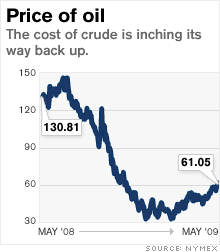Oil gains on dollar weakness
Price of crude ends above $61 a barrel . Report showing China's demand for energy recovering also boosts prices.

NEW YORK (CNNMoney.com) -- Oil prices rose Friday as the dollar lost ground on growing woes over the creditworthiness of the U.S. and as a report showed that demand for oil is recovering in China.
A backdrop of continued economic weakness kept oil prices relatively steady.
Light sweet crude for July delivery settled up 62 cents to $61.67 a barrel Friday.
The falling dollar supported oil prices. Given that crude oil is traded in dollars around the globe, when the dollar softens, oil prices rise. The euro gained 1.1% and the pound gained 0.6% against the U.S. currency.
The dollar was pushed to new lows as investors questioned the credit worthiness of U.S. debt in aftermath of rating agency S&P's downgrade of the U.K.'s forecast to "negative" due to overwhelming debt load.
"These worries sank the dollar to new lows for the year and drove oil and gold higher," said Phil Flynn, senior market analyst at Alaron Trading, in his daily research note.
Wednesday, oil settled at a six-month high. Crude prices have made dramatic swings in the past year, having hit a record high of $147 a barrel last July. Demand for oil then plummeted as the global recession forced businesses and consumers to cut back, puling oil down to just shy of $34 a barrel in December.
As investor sentiment improved - along with the U.S. stock markets - oil prices rose as well. Oil has hovered around $60 a barrel in recent weeks, and economists say that is a pretty safe place for oil to stay.
While the price of oil has been moving recently because of its place as an investor asset, fundamental supply and demand have also been a factor. For example, turmoil in oil-rich Nigeria has threatened pipelines of supply.
A report released Thursday also showed that Chinese demand for oil posted its first year-on-year increase in six months. China, the world's second-largest oil consumer after the U.S., used 31.47 million metric tons of oil in April, up 4% from the same month a year ago, according to a Platts analysis of official data.
"April's implied oil demand from China is another signal to the markets that the first seedlings of a broad stabilization and recovery in oil demand are starting to poke through around the world," said Dave Ernsberger, Senior Editorial Director for Asia at Platts, in a written statement.
Next week, the leaders of the nations of Organization of Petroleum Exporting Countries will meet in Vienna, Austria, to debate whether production quotas need to be massaged.
The increase in oil prices has been affecting consumers at the pump. Retail gas prices have climbed for 24 consecutive days, leading up to the official kickoff for the summer driving season, this Memorial Day weekend.
The national average price for a gallon of regular unleaded gasoline jumped almost three cents on Friday to $2.391, up from the previous day's price of $2.362.
In the past 24 days, the average price of gas has increased 34.3 cents, or 16.7%. The average price of a gallon of gas is down $1.72, or 41.8%, from the record high price of $4.114 that AAA reported on July 17, 2008. ![]()


